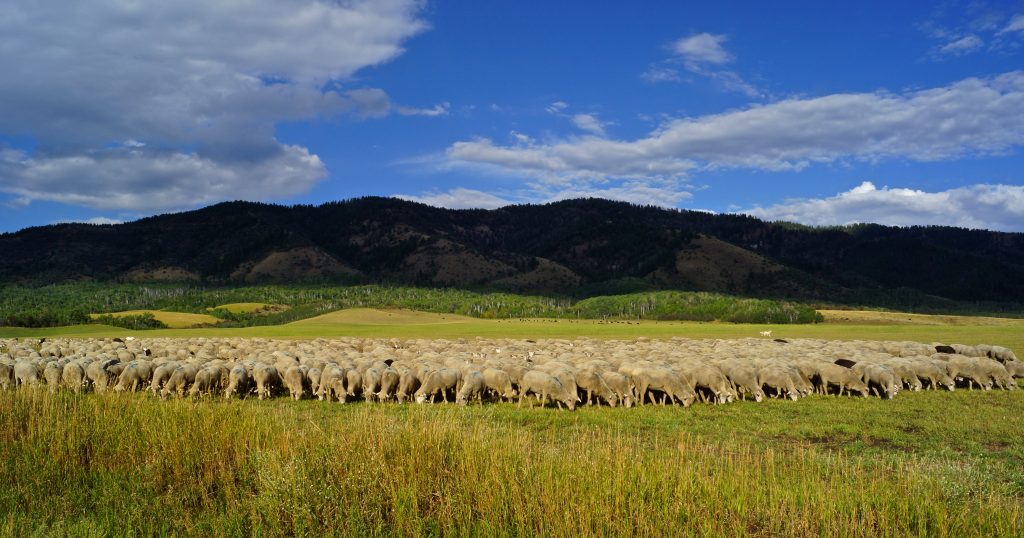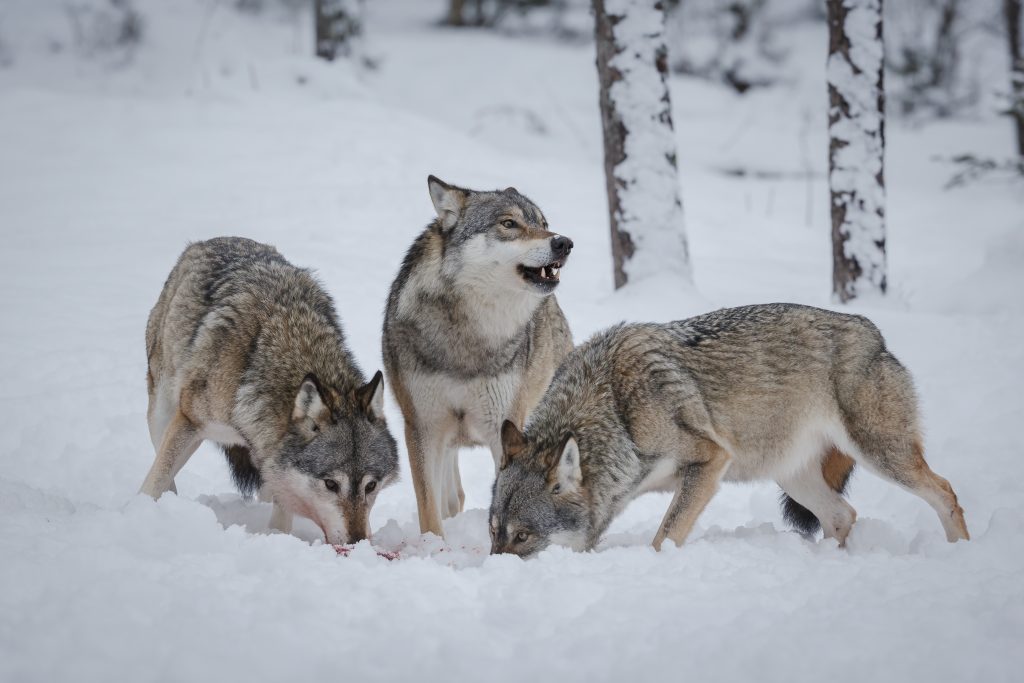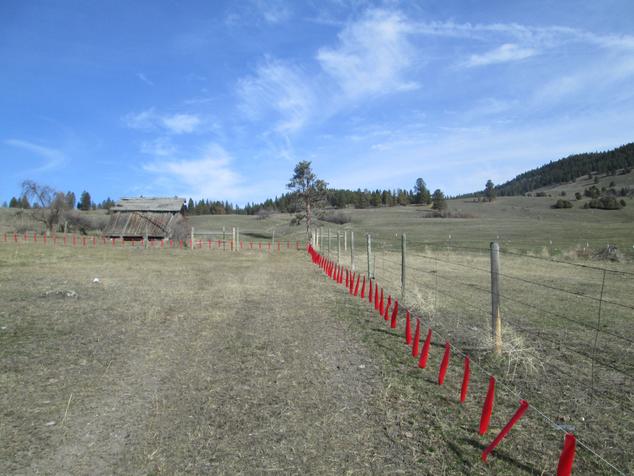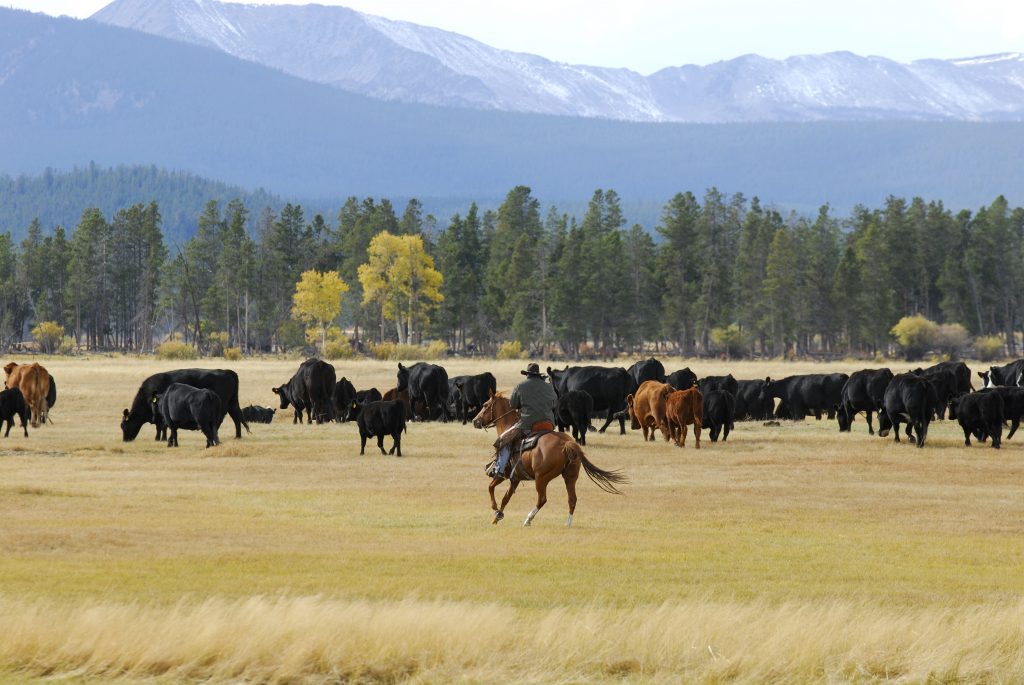by the Center for Human-Carnivore Coexistence (5/20)
Key Points….
- Impacts to livestock from wolves creates costs borne by livestock producers, including mortality from wolf predation and other indirect impacts. These costs are unevenly distributed and localized, with some producers suffering greater losses than others. Although wolf depredation is a small economic cost to the livestock industry as a whole, the impacts to individual producers can be substantial.
- On rare occasions wolves only eat a portion of what is killed. Such events can have negative economic impacts and reinforce negative perceptions towards wolves. They are therefore important to minimize and prevent.
- Wildlife managers and livestock producers have a variety of management tools to reduce conflict with wolves. This entails alterations in livestock practices and/or efforts to manage wolves. Both non-lethal and lethal tools can be effective and used proactively to prevent conflict or reactively after conflict has occurred.
What are the potential impacts of wolves on livestock in Colorado?

Impacts to livestock from wolves creates costs borne by livestock producers (see Wolf Economics Information Sheet). Calculating these costs, including mortality from wolf predation and other indirect impacts, is challenging. Part of the problem is not knowing exactly how many livestock are killed by wolves each year. For example, in the Northern Rocky Mountain states of Montana, Idaho, and Wyoming, the U.S. Fish and Wildlife Service (USFWS) confirmed a total of 136 cattle (both adults and calves) and 114 sheep (adults and lambs) killed by wolves in 2014.1 In contrast, the National Agricultural Statistics Service (NASS) reported 2,835 cattle and 453 sheep killed by wolves in the same region and year.2,3 The USFWS data are underestimates because they don’t include livestock that are killed by wolves but are never found or reported.4,5 The NASS numbers are based on a self-reported survey of livestock producers and do not include verification of kills. This leaves the accuracy of the NASS data in question, and the reports likely overestimate the number of livestock killed by wolves.6
One way to estimate impact of wolves on the livestock industry is to calculate the proportion of livestock killed by wolves out of the total number of livestock in counties with wolves. Using USFWS data of confirmed wolf kills1 and NASS data of number of cattle2, the calculated percentage of cattle killed by wolves in the Northern Rocky Mountain states is under 1%. However, this calculation ignores livestock that are not vulnerable to predation (e.g., in feedlots or on range where wolves do not occur) and thus likely underestimates the percentage. Nonetheless, the available data suggest that mortality caused by wolves is a small economic cost to the livestock industry as a whole.7
However, in addition to mortalities, producers can also suffer indirect losses such as stress, sickness, and reduced weight gain and pregnancy rates when wolves scare, chase, or attack livestock.8-11 The indirect effect of wolves on livestock is not well studied so estimating the extent of indirect losses is difficult. Costs could be considerably higher when including unseen deaths, indirect losses, and expenses for producers to deter wolves or to seek compensation (see Wolf Economics Information Sheet).9 Indirect losses might be more likely on ranches where wolves are already killing cattle.10
Although wolf depredation on cattle and sheep accounts for less than 1% of the annual gross income from industry-wide livestock operations in the Northern Rocky Mountains, these costs are unevenly distributed and localized, with some producers suffering greater losses than others.7,12 For those impacted by wolf predation, the economic and emotional impacts can be substantial. Both direct and indirect losses could significantly affect the livelihood of individual ranchers operating on thin profit margins in volatile markets. At a stakeholder workshop in February 2020, ranchers shared their belief that wolf reintroduction poses a threat to rancher’s security regarding their livelihood and way of life.13
Understanding why some producers are more vulnerable to wolf predation and others are not is an active area of research.14 The answer likely includes where livestock are grazed (some areas have more wolf activity than others); the type of livestock (sheep are more vulnerable than cattle); the type of operation (e.g., cow/calf versus stocker); range versus pasture operations; and how much the livestock are protected.
Do wolves sometimes kill more prey than they can eat?
On rare occasions predators kill many animals in excess of their food needs and only eat a portion of what is killed. This is sometimes called surplus killing, excess killing, or partial prey consumption.15-21 This behavior has been documented in a wide variety of predators, including wolves, foxes, weasels, bears, shrews, spiders, and insects.19 One of the better-known examples of partial prey consumption involves grizzly bears catching salmon, only eating the eggs and other select body parts, and discarding most of the remaining fish. Bears do this when there are so many fish that are easy to catch they can consume only the most nutritious and calorie rich parts of each caught fish.

For wolves, this type of predation event can occur on native ungulates such as deer, moose, or caribou17-19 and livestock such as sheep.7 It is generally believed that the vulnerability of the prey plays a large role in excess killing. For example, a study in Minnesota found that after an unusually severe winter, white-tailed deer were in very weak condition and for a few weeks wolves killed deer at much higher rates than normal and only partially consumed the carcasses.18 Like the bear example, wolves were likely trying to maximize their energetic gain and taking advantage of a short period when their prey was vulnerable.
Surplus killing on livestock may be more frequent than on wild prey because livestock are typically more vulnerable to predation.7 One study found that in the Northern Rocky Mountains from 1987-2003, wolves excessively killed sheep but not cattle. On average there were about 3 surplus killing events on sheep per year and an average of 8.85 sheep killed per attack.7 Compared to cattle, sheep and goats are thought to be more vulnerable because of their smaller size, fewer defenses (e.g., horns), and their tendency to occur in flocks that can supply large numbers of concentrated prey. Another factor is that corrals and other enclosures for livestock can make it easier to catch multiple livestock.21
Although uncommon, such events can have negative economic impacts for producers. Such events can also be viewed as needless killing, reinforcing negative perceptions towards wolves. They are therefore important to minimize and prevent using approaches described below.
What management tools are available to reduce livestock conflict with wolves?
Wildlife managers use a variety of strategies to prevent or reduce livestock conflict with wolves. Some tools are reactive, meaning management occurs after the conflict happened. Other tools are proactive, meaning management occurs prior to conflict. Management actions are often situation-dependent and involve an integrated approach, combining both lethal and non-lethal methods.
Lethal methods can include regulated hunting (proactive) or targeted removal (reactive). Regulated hunting of wolves can limit wolf populations.22-25 Lethal removal of wolves in reaction to conflict, for example killing livestock, can be effective if targeted to the correct individuals.26-28 Some studies have suggested that lethal removal of wolves only temporarily reduces depredation and actually may eventually increase conflicts.29-31 For example, one study concluded that killing wolves may displace depredations to neighboring properties.31 Another study reported that lethal removal might increase depredations the following year as new wolves breed and fill vacancies29, although these conclusions were contradicted when other researchers re-analyzed these data.32

Proactive non-lethal tools can help prevent conflict. Such tools often focus on modifying wolf, livestock, and/or human behavior to minimize encounters.26,33-35 For example, physical or psychological barriers or scare tactics can be established to try to ward off wolves and other predators. These include fencing, fladry (flagging), lights, and sound devices, which rely on novelty and are effective at least temporarily.36 Livestock guardian dogs also can deter wolves, although wolves also can kill guard dogs and thus finding the right breed and number of guard dogs is important.37 Wolves also tend to avoid humans, so people accompanying livestock (e.g., herders, range riders, or scouts) can reduce encounters and also help manage herds proactively.38 Modifying livestock management practices can help,26,33,39 particularly during calving or lambing when animals are most vulnerable. For example, grazing strategies can be altered to avoid wolves, for instance by moving livestock away from known wolf dens. Removal of carcasses of livestock that have died can also be useful, as carcasses attract wolves and other predators. Such non-lethal tools entail costs in terms of time, labor, and money that need to be considered if they are to be implemented.
For all of these strategies the scale and the context will determine whether or not they are effective. For example, fladry is only appropriate for small pastures, guard dogs are only effective if they are large enough or in a big enough group to deter wolves, and livestock that are spread widely across a landscape are more difficult to protect.

Local communities can apply combinations of strategies and tools. For example, the ranching community in the Blackfoot Valley of Montana uses a collaborative, grass-roots approach to reduce conflicts with predators through proactive strategies.39 They remove and compost livestock carcasses, fence calving areas, and employ wildlife technicians to monitor livestock and wolves. This has helped reduce both the number of livestock and wolves killed in the community. The program is funded from a combination of sources, including governmental agencies, private foundations, corporations, and individual donations.40
In addition, producers can be financially compensated for livestock lost to wolves (see Wolf Economics Information Sheet).7-9,41,42 Such programs are often underutilized by producers. These compensation programs have also been criticized for their high costs and burden of proof to verify kills, inadequate funding to fully compensate for losses, and lack of incentives to prevent conflict. Alternative incentive models, where producers are paid to coexist with wildlife, including carnivores, are being proposed as we learn from ongoing programs.41,43 These models are commonly referred as “payment for ecosystem services”.
Several useful manuals exist to help landowners with approaches to reduce conflict between livestock and wolves.44-46 These documents review in more detail the variety of tools and best management practices available to reduce and even prevent livestock losses to predators.
References
- U.S. Fish and Wildlife Service et al. 2015. Northern Rocky Mountain Wolf Recovery Program 2015 Interagency Annual Report. M.D. (Jimenez and S.A. Becker, eds) USFWS, Ecological Services, 585 Shepard Way, Helena, Montana, 59601.
- USDA. 2015. Cattle and Calves Death Loss in the United States Due to Predator and Nonpredator Causes, 2015. USDA–APHIS–VS–CEAH. Fort Collins, CO #745.1217
- USDA. 2015. Sheep and Lamb Predator and Nonpredator Death Loss in the United States, 2015. USDA–APHIS–VS–CEAH–NAHMS Fort Collins, CO #721.0915
- Oakleaf, J.K., Mack, C., Murray, D.L., 2003. Effects of wolves on livestock calf survival and movements in central Idaho. Journal of Wildlife Management 67, 299–306.
- Breck, S.W., B.M. Kluever, M. Panasci, J. Oakleaf, D.L. Bergman, W. Ballard and L. Howery. 2011. Factors affecting predation on calves and producer detection rates in the Mexican wolf recovery area. Biological Conservation 144:930-936.
- Kovacs, K. E., K.E. Converse, M.C. Stopher, J.H. Hobbs, M.L. Sommer, P.J. Figura, D.A. Applebee, D.L. Clifford, and D.J. Michaels. Conservation Plan for Gray Wolves in California. 2016. California Department of Fish and Wildlife, Sacramento, CA 329 pp.
- Muhly, T.B. and M. Musiani. 2009. Livestock depredation by wolves and the ranching economy in the Northwestern U.S. Ecological Economics 68: 2439–2450.
- Sommers, A.P., Price, C.C., Urbigkit, C.D. and Peterson, E.M., 2010. Quantifying economic impacts of large‐carnivore depredation on Bovine calves. The Journal of Wildlife Management, 74(7), pp.1425-1434.
- Steele, J.R., Rashford, B.S., Foulke, T.K., Tanaka, J.A. and Taylor, D.T., 2013. Wolf (Canis lupus) predation impacts on livestock production: direct effects, indirect effects, and implications for compensation ratios. Rangeland Ecology & Management, 66(5), pp.539-544.
- Ramler, J.P., Hebblewhite, M., Kellenberg, D. and Sime, C., 2014. Crying wolf? A spatial analysis of wolf location and depredations on calf weight. American Journal of Agricultural Economics, 96(3), pp.631-656.
- Richard B. Harris. April 24, 2020. Economic instruments to encourage coexistence between Montana livestock producers and large carnivores, Unpublished Background Discussion Paper, Montana Fish, Wildlife, and Parks
- Bradley, E.H. and D.H. Pletscher. 2005. Assessing factors related to wolf depredation of cattle in fenced pastures in Montana and Idaho. Wildlife Society Bulletin 33:1256-1265.
- Niemiec RM. (2020). Report: A Summary of Key Perspectives Shared at the February, 2020, Stakeholder Discussion on the Conflict Over Potential Wolf Restoration and Management in Colorado. Fort Collins, CO: Colorado State University, Department of Human Dimensions of Natural Resources.
- Amirkhiz, R.G., J.K. Frey, J.W. Cain III, S.W. Breck, D.L. Bergman. 2018. Predicting spatial factors associated with cattle depredations by the Mexican wolf (Canis lupus baileyi) with recommendations for depredation risk modeling. Biological Conservation 224: 327-335.
- Kruuk, H., 1972. Surplus killing by carnivores. Journal of Zoology, 166(2), pp.233-244.
- Short, J., Kinnear, J.E. and Robley, A., 2002. Surplus killing by introduced predators in Australia—evidence for ineffective anti-predator adaptations in native prey species?. Biological Conservation, 103(3), pp.283-301.
- Miller, F.L., Gunn, A. and Broughton, E., 1985. Surplus killing as exemplified by wolf predation on newborn caribou. Canadian Journal of Zoology, 63(2), pp.295-300.
- DelGiudice, G.D. 1998. Surplus killing of white-tailed deer by wolves in northcentral Minnesota. Journal of Mammalogy 79:227-235.
- Vucetich, J.A., Vucetich, L.M. and Peterson, R.O., 2012. The causes and consequences of partial prey consumption by wolves preying on moose. Behavioral Ecology and Sociobiology, 66(2), pp.295-303.
- Zimmermann, B., Sand, H., Wabakken, P., Liberg, O. and Andreassen, H.P., 2015. Predator‐dependent functional response in wolves: From food limitation to surplus killing. Journal of Animal Ecology, 84(1), pp.102-112.
- Weise, F.J., Tomeletso, M., Stein, A.B., Somers, M.J., & Hayward, M.W. 2020. Lions Panthera leo prefer killing certain cattle Bos taurus types. Animals, 10(4), 692.
- Mech, L. David; Boitani, Luigi, eds. (2003). Wolves: Behavior, Ecology and Conservation. University of Chicago Press. p. 230. ISBN 978-0-226-51696-7.
- Adams, L.G., Stephenson, R.O., Dale, B.W., Ahgook, R.T. and Demma, D.J., 2008. Population dynamics and harvest characteristics of wolves in the central Brooks Range, Alaska. Wildlife Monographs, 170(1), pp.1-25.
- Ausband, D.E., 2016. Gray wolf harvest in Idaho. Wildlife Society Bulletin, 40(3), pp.500-505.
- Ausband, D.E., Mitchell, M.S., Stansbury, C.R., Stenglein, J.L. and Waits, L.P., 2017. Harvest and group effects on pup survival in a cooperative breeder. Proceedings of the Royal Society B: Biological Sciences, 284(1855), p.20170580.
- Bangs, E., Jimenez, M., Niemeyer, C., Fontaine, J., Collinge, M., Krsichke, R., Handegard, L., Shivik, J.A., Sime, C., Nadeau, S. and Mack, C., 2006. Non-lethal and lethal tools to manage wolf-livestock conflict in the northwestern United States. In Proceedings of the Vertebrate Pest Conference (Vol. 22, No. 22).
- Harper, E.K., Paul, W.J., Mech, L.D. and Weisberg, S., 2008. Effectiveness of lethal, directed wolf‐depredation control in Minnesota. The Journal of Wildlife Management, 72(3), pp.778-784.
- Bradley, E.H., Robinson, H.S., Bangs, E.E., Kunkel, K., Jimenez, M.D., Gude, J.A. and Grimm, T., 2015. Effects of wolf removal on livestock depredation recurrence and wolf recovery in Montana, Idaho, and Wyoming. The Journal of Wildlife Management, 79(8), pp.1337-1346.
- Wielgus, R.B. and Peebles, K.A., 2014. Effects of wolf mortality on livestock depredations. PloS one, 9(12).
- Treves, A., Krofel, M. and McManus, J., 2016. Predator control should not be a shot in the dark. Frontiers in Ecology and the Environment, 14(7), pp.380-388.
- Santiago-Avila, F.J., Cornman, A.M. and Treves, A., 2018. Killing wolves to prevent predation on livestock may protect one farm but harm neighbors. PloS one, 13(1).
- Poudyal, N., Baral, N. and Asah, S.T., 2016. Wolf lethal control and livestock depredations: counter-evidence from respecified models. PloS one, 11(2), p.e0148743.
- Stone, S.A., Breck, S.W., Timberlake, J., Haswell, P.M., Najera, F., Bean, B.S. and Thornhill, D.J., 2017. Adaptive use of nonlethal strategies for minimizing wolf–sheep conflict in Idaho. Journal of Mammalogy, 98(1), pp.33-44.
- Much, R.M., Breck, S.W., Lance, N.J. and Callahan, P., 2018. An ounce of prevention: Quantifying the effects of non-lethal tools on wolf behavior. Applied animal behaviour science, 203, pp.73-80.
- Young, J.K., Steuber, J., Few, A., Baca, A. and Strong, Z., 2018. When strange bedfellows go all in: a template for implementing non-lethal strategies aimed at reducing carnivore predation of livestock. Animal Conservation, p.1.
- Shivik, J.A. 2006. Tools for the edge: What’s new for conserving carnivores. BioScience, 56, pp. 253-259.
- Kinka, D. and Young, J.K., 2018. A livestock guardian dog by any other name: similar response to wolves across livestock guardian dog breeds. Rangeland Ecology & Management, 71(4), pp.509-517.
- Parks, M. and Messmer, T., 2016. Participant perceptions of Range Rider Programs operating to mitigate wolf–livestock conflicts in the western United States. Wildlife Society Bulletin, 40(3), pp.514-524.
- Wilson, S.M., Bradley, E.H. and Neudecker, G.A., 2017. Learning to live with wolves: community-based conservation in the Blackfoot Valley of Montana. Human–Wildlife Interactions, 11(3), p.4.
- Blackfoot Challenge. 2020. Financials.
- Lee, T., Good, K., Jamieson, W., Quinn, M. and Krishnamurthy, A., 2017. Cattle and carnivore coexistence in Alberta: the role of compensation programs. Rangelands, 39(1), pp.10-16.
- Ravenelle, J. and Nyhus, P.J., 2017. Global patterns and trends in human–wildlife conflict compensation. Conservation Biology, 31(6), pp.1247-1256.
- Dickman, A.J., Macdonald, E.A. and Macdonald, D.W., 2011. A review of financial instruments to pay for predator conservation and encourage human–carnivore coexistence. Proceedings of the National Academy of Sciences, 108(34), pp.13937-13944.
- Western Landowners Alliance. 2020. Reducing conflict with grizzly bears, wolves and elk: A western landowners guide.
- Defenders of Wildlife. 2016. Livestock and wolves: A guide to nonlethal tools and methods to reduce conflicts. 2nd Edition.
- People and Carnivores. 2020. Solutions that work for people and wildlife: Manuals/Guides.





